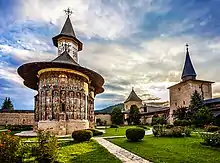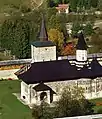Sucevița Monastery
Sucevița Monastery is an Eastern Orthodox convent situated in the Northeastern part of Romania. It is situated near the Suceviţa River, in the village Sucevița, 18 km away from the city of Rădăuţi, Suceava County. It is located in the southern part of the historical region of Bukovina (northwestern Moldavia). It was built in 1585 by Ieremia Movilă, Gheorghe Movilă and Simion Movilă.[1]
| Sucevița Monastery | |
|---|---|
Mănăstirea Sucevița | |
 The church and the courtyard of Sucevița Monastery | |
| Religion | |
| Affiliation | Eastern Orthodox |
| Ecclesiastical or organizational status | Nunnery |
| Patron | Resurrection of Jesus |
| Status | Active |
| Location | |
| Location | Sucevița, Suceava County, Romania |
| Geographic coordinates | 47°46′41.36″N 25°42′40.42″E |
| Architecture | |
| Style | Byzantine, Gothic |
| Founder | Gheorghe Movilă |
| Groundbreaking | 1581 |
| Completed | 1601 |
The architecture of the church contains both Byzantine and Gothic elements, and some elements typical to other painted churches of northern Moldavia. Both interior and exterior walls are covered by mural paintings, which are of great artistic value and depict biblical episodes from the Old and New Testament. The paintings date from around 1601, which makes Sucevița one of the last monasteries to be decorated in the famous Moldavian style of exterior paintings.
The interior court of the monastic ensemble is almost square (100 by 104 meters) and is surrounded by high (6 m), wide (3 m) walls. There are several other defensive structures within the ensemble, including four towers (one on each corner). Sucevița was a princely residence as well as a fortified monastery. The thick walls today shelter a museum that presents an outstanding collection of historical and art objects. The tomb covers of Ieremia and Simion Movilă – rich portraits embroidered in silver thread – together with ecclesiastical silverware, books and illuminated manuscripts, offer eloquent testimony to Sucevița's importance first as a manuscript workshop, then as a printing center.
In 2010, the monastery has been inscribed by UNESCO on its list of World Heritage Sites, as one of the Painted churches of Moldavia. It is also the second major attraction along the Via Transilvanica long-distance trail, after Putna Monastery.[2]
Burials
Gallery
 View of the ensemble, with the walls in the background
View of the ensemble, with the walls in the background Different angle
Different angle%252C_krzy%C5%BC_na_dziedzi%C5%84cu_klasztornym.jpg.webp) Cross the courtyard of the monastery
Cross the courtyard of the monastery%252C_monastyr%252C_fragment_fresku%252C_stworzenie_Ewy.jpg.webp) The fresco in the monastery
The fresco in the monastery One of the four towers
One of the four towers Entrance
Entrance
See also
References
- "Tourism - Sucevita Monastery". Archived from the original on 28 April 2016. Retrieved 8 April 2016.
- "Bucovina | Via Transilvanica". www.viatransilvanica.com. Retrieved 2023-08-10.
External links
- Sucevița Monastery
- Romania's Painted Churches, Cloud9.net
- Mănăstirea Suceviţa (pe TravelWorld.ro)
- Informaţii detaliate